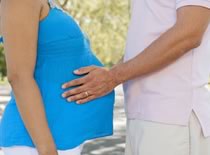Considerations for Pregnant Women who are More likely to be Exposed to Novel H1N1 Flu (Swine Flu) at work; Information for Women in Education, Child Care, and Health Care.
May 3, 2009 12:00 PM ET
 This information is for pregnant women who work in jobs where they are more likely to be exposed to people with confirmed, probable, or suspected novel H1N1 virus infection.
This information is for pregnant women who work in jobs where they are more likely to be exposed to people with confirmed, probable, or suspected novel H1N1 virus infection.
Schools and child care workers
Pregnant women working in school settings (e.g. teachers, day care workers) should follow the same guidance as nonpregnant school workers and the general public.
H1N1 Flu (Swine Flu) and You
Guidance for Schools K-12
Alert for institutions of higher learning
Health care workers
 All health care workers in direct patient care, including pregnant women, should follow standard precautions with all patients, regardless of infection status (http://www.osha.gov/Publications/OSHA_pandemic_health.pdf, page 15).
All health care workers in direct patient care, including pregnant women, should follow standard precautions with all patients, regardless of infection status (http://www.osha.gov/Publications/OSHA_pandemic_health.pdf, page 15).
Health care workers treating patients with suspected or known illness easily transmitted by contact, droplet, or airborne transmission (e.g. influenza viruses) should do a risk assessment to determine the type of transmission-based precautions needed. Contact, droplet, or airborne precautions may be indicated (http://www.osha.gov/Publications/OSHA_pandemic_health.pdf, pages 16-17).
Pregnant women who will likely be in direct contact with patients with confirmed, probable, or suspected influenza A (H1N1) (e.g., a nurse, physician, or respiratory therapist caring for hospitalized patients), should consider reassignment to lower-risk activities, such as telephone triage.
If reassignment is not possible, pregnant women should avoid participating in procedures that may generate increased small-particle aerosols of respiratory secretions in patients with known or suspected influenza, including the following procedures:
- Endotracheal intubation
- Aerosolized or nebulized medication administration
- Diagnostic sputum induction
- Bronchoscopy
- Airway suctioning
- Positive pressure ventilation via face mask (e.g., BiPAP and CPAP)
- High-frequency oscillatory ventilation
Guidance on pre-exposure and post-exposure chemoprophylaxis with antiviral agents, including for pregnant women can be found at http://www.cdc.gov/h1n1flu/recommendations.htm.
For additional guidance for health care providers please visit http://www.cdc.gov/h1n1flu/guidelines_infection_control.htm.
- Links to non-federal organizations are provided solely as a service to our users. These links do not constitute an endorsement of these organizations or their programs by CDC or the federal government, and none should be inferred. CDC is not responsible for the content of the individual organization Web pages found at these links.
Get email updates
To receive daily email updates about this site, enter your email address:
Contact Us:
- Centers for Disease Control and Prevention
1600 Clifton Rd
Atlanta, GA 30333 - 800-CDC-INFO
(800-232-4636)
TTY: (888) 232-6348
24 Hours/Every Day - cdcinfo@cdc.gov


